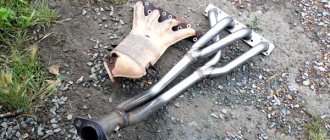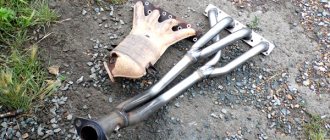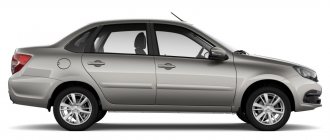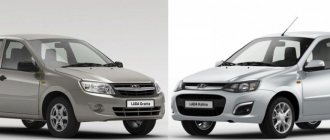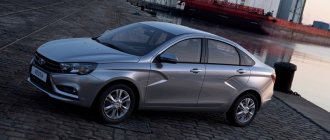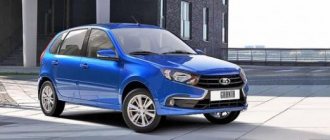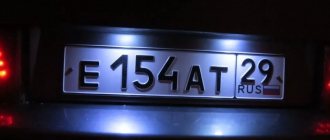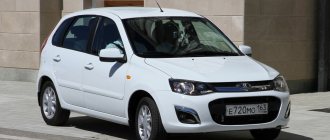The modern “VAZ” model Lada Granta has justifiably gained popularity over its history (since 2011) in the market space and has become a worthy replacement for the outdated “fifteenth”. In the first couple of years of its existence, every 15th model sold on the Russian market was a Lada Granta. Multiple demands forced the manufacturer to resort to production optimization. Since 2014, a new modification at that time - the liftback - has been officially sold. The then new product had a more advantageous design and improved design solutions. After the release of the progressive modification, many car enthusiasts wondered which Lada Granta liftback or sedan body to give preference to? And in order to understand which is better, and actually what to choose, you need to compare the versions.
Next, we will dwell in detail on the differences between the designated versions of the Lada Granta liftback and, accordingly, the sedan in order to identify the priority option in terms of consumer qualities.
Comparison of Lada Granta liftback and sedan
safety
suspension was installed on the luxury vehicle
, having gas-filled shock absorbers, thicker stabilizers and stiffer springs. Other trim levels come with the standard sedan suspension.
trunk for both a liftback and a hatchback.
. And although at first glance it is smaller than that of the sedan - 480 versus 440 liters, when folding the rear seats its volume increases by more than one and a half times (760 liters). These figures significantly exceed those of the Lada Kalina, the trunk limit of which stops at 670 liters.
The interior of the Lada Granta
has remained virtually unchanged compared to its sedan predecessor. The same console, instrument panel, the same seats. There is enough space in the back seat for three passengers to feel quite comfortable. The only question is the space above your head. If your height is 190 cm or less, you will be comfortable, but taller passengers will find the car uncomfortable.
Conducting
test drives of the Lada Granta liftback
, many drivers noted that the combination of a powerful engine and relatively low weight (1070 kg) provides decent dynamics for an inexpensive car. The main thing is not to accelerate the car above 150 km/h, since handling and directional stability at top speeds are not at all impressive. With a quiet ride, thanks to the elastic suspension, which is optimal for our roads, the Lada Granta leaves the most pleasant impression.
You can also reward
the brakes
, both during emergency and normal braking.
But the advertised sound insulation
raises complaints: when driving dynamically, the cabin is noisy, and you have to speak much louder to have a conversation. Installing additional sound insulation will solve the problem.
Average fuel consumption
in the city with a manual transmission it is 7.9 liters per hundred kilometers, while on the highway it is one liter less. “Automatic”, of course, is more voracious: on average 9.6 liters per hundred kilometers in the city and 8.5 on the highway. However, these are quite modest figures.
Summarizing _
, we can say that, despite certain shortcomings, the Lada Granta liftback fully justifies its price and has every chance of becoming a bestseller among economy class models. Finally, video review of the Lada Granta hatchback:
Pendant: which one would you like?
But the most interesting changes occurred in the chassis of the five-door Granta. Thus, although cars in the “Standard” and “Norma” versions received an improved suspension, the changes in it were reduced mainly to different settings. But in the “Lux” version, the liftback suspension is significantly different from the sedan: anti-roll bars both front and rear are much more powerful, gas-filled shock absorbers and stiffer springs are installed.
The purpose of all these innovations, according to S. Medinets, was to increase the stability of the car in corners, reduce roll and sway. The suspension of the luxury liftback is denser and more collected than on the sedan, although, according to our interlocutor, we had to sacrifice a little smoothness. And he himself considers the ideal option for our roads to be the suspension in the “Standard” and “Norma” versions with conventional liquid shock absorbers and the same springs as on the sedan: “Such a car is not as accurate in reactions as a luxury one, but it “swallows” better "Typical Russian road defects."
And finally, a new vacuum brake booster, which the Lada Granta liftback received. As a result, the pedal travel, according to our feelings, has become shorter, and the force on it increases as the braking progresses, not as sharply as before. And in general, it has become more informative and accurate.
Body differences
money-trans.ru The difference between subrogation and recourse.
What is the difference between recourse and subrogation under compulsory motor insurance. Cases of recourse in insurance Undoubtedly, two body types belong to the class of passenger cars. In terms of their properties and characteristics, they are equivalent to sedans. Now let's compare them:
- The liftback is very sedan-like due to its relatively long rear overhang;
- The hatchback has a one-volume body, i.e. the luggage compartment and interior are combined into one whole space;
- the liftback has a couple of versions for opening the rear door;
- Liftbacks are almost all two-volume, but there are also three-volume ones. *In addition, read the article " ".
Nevertheless, as a separate type of liftback body it is very difficult to distinguish; most people will classify it as one or another more common type of body.
Buying a car can be a very tedious process, especially if it is your first time. The future owner wants to satisfy all his needs. The choice depends on the cost of the car, the number of family members (for family people), the type of fuel, the age of the car (new or used)
Also, when buying a used car, special attention is paid to the number of owners, mileage and technical condition. However, today we will look at, in my opinion, the most important criterion for choosing a car, which determines its functionality
As you might have guessed, we will talk about body type.
Comparison of liftback and hatchback
As soon as car production began to be more large-scale than a couple of copies per year, then different types of cars began to appear, which were oriented towards certain needs. Comfortable sedans, sports coupes, luxurious convertibles and much, much more appeared. Today, due to design achievements and technological progress, many types of car bodies are combined in one, which is how crossovers, four-door coupes and others were born. But we will outline, perhaps, the most popular and clearly differentiated body types
:
- Sedan;
- Hatchback;
- Station wagon;
- Minivan;
- Coupe;
- Cabriolet;
- SUV.
However, the list goes on and the differences between types can be quite subtle. But we will study in detail and determine the differences between a hatchback and a liftback. Despite the fact that the liftback is, in fact, a subtype of the hatchback, they still have tangible features.
Price
The minimum equipment level of the liftback is rated higher than the “Standard” version found in the sedan. More specifically, you will have to pay 314.8 thousand rubles for the liftback. Whether it is rational to overpay for the improvements indicated here is up to the buyer to decide.
The manufacturer plans to equip the sedan with the options present in the liftback in the near future. The restyling process for the LADA Granta is expected to be carried out this year. Today, the liftback has a number of undeniable advantages over the sedan regarding the exterior and driving parameters, but still, which is better, everyone chooses for themselves. When choosing a suitable modification, you should first study the full list of features. It is also not recommended to neglect your own priorities and preferences. Consider the difference between modifications not only in characteristics and equipment, but also in a financial sense. If you are willing to pay more for a presentable design, interior improvements and slightly increased performance, then the liftback is your option. But in fairness, we note that today the liftback is brighter and more balanced in comparison with the sedan, and this allows us to mark it as the leader of our review.
About configurations
Lada Granta hatchback liftback
Standard
Equipment " Norma
The Lada Granta liftback offers two engine options: the first – with a volume of 1.6 liters and a power of 87 hp, the second – also with a volume of 1.6 liters, but with a power of 106 hp. Also included in the package are ABS and BAS systems (brake assist), an on-board computer, electric power steering, electric windows on the front doors and a multimedia system.
The Lada Granta hatchback, despite the initial “low cost” concept of the car, was able to acquire the “ Luxury”
"with interesting characteristics. A 98 hp engine is available in the luxury package, and most importantly, it can be combined with an automatic transmission. In addition, a stability control system, fog lights, an airbag for passengers, heated front seats and a climate system become available. See also the Grants liftback configuration table.
Transformations affecting the chassis and body components
The manufacturer made every effort to eradicate the flaws inherent in the sedan.
The Lada Granta configurations in the “Standard” and “Norma” versions have acquired new settings in the suspension, where a special role is given to modified shock absorbers. The springs were carried over from the sedan. The suspension has become more suitable for country roads. Here passengers perceive bumps and potholes more comfortably.
The luxury equipment will delight you with a new suspension design, where a powerful stabilizer and rigid spring elements are located as a separate link. This solution is aimed at increasing stability and reducing amplitude during rolls.
Also, you should not ignore the gas-filled shock absorbers, which were previously equipped exclusively with LADA sports cars. The brake unit has increased responsiveness and information content due to the use of an updated vacuum booster.
The ground clearance has increased by 15mm, which will be especially gratifying for those who like to conquer off-road terrain.
If we compare, the design of the liftback does not imply the presence of a body-strengthening bulkhead located in the stern. The rigidity of the body frame was increased by strengthening the underbody and roof panel, as well as making adjustments to the design of the middle spar.
Updated Lada Granta first photos and videos of the liftback
What are the differences between start and launch? Please provide examples.
Let us remind you that AVTOVAZ intends to restyle the Lada Granta and Lada Kalina models, after which they will be combined into one family. Thus, the Kalina name will be removed from the manufacturer’s line, and the Granta model will be available in five body types: sedan, liftback, five-door hatchback, station wagon and cross-station wagon.
The updated Lada Granta sedan, the appearance of which was redesigned in accordance with the X-style that debuted on the Vesta and Xray models, was presented by AVTOVAZ earlier. After restyling, the four-door received an updated front end with new headlights, radiator grille, bumper, hood and fenders.
Now on the community page “Lada Granta FL Club” on the social network “VKontakte” photos and videos of the restyled Lada Granta liftback have been published. The car was filmed during advertising filming, so there is no camouflage on its body. You can notice that the front part of the liftback is completely identical in design to the sedan presented earlier, but the rear, apparently, has not changed.
The manufacturer has not yet published pictures of the interior of the restyled Granta, but the above-mentioned community posted a picture of the front panel of the new product, which is built on the basis of the Kalina panel and is practically no different from it.
The public premiere of the updated Lada Granta will probably take place at the International Moscow Motor Show at the end of August, where the Lada Granta Sport sedan will presumably also be presented.
It should be noted that earlier the Kolesa.ru portal published live photos of the Lada Granta hatchback, previously sold under the name Kalina.
"Closer effect"
It’s nice that VAZ engineers, while working on the new product, tried to correct the errors that irritate the owners of the “traditional” Granta body (the main complaints were formulated by members of Lada Granta owners’ clubs). So, noise insulation has been significantly improved here: the Granta in a five-door body is perceived as a much quieter car than a sedan. Especially in the version with automatic transmission. The improved manual transmission (on the liftback it is exclusively cable) still does not get rid of the characteristic noise.
In addition, the liftback received new front door stops, thanks to which creaking noises disappeared when opening, and even a “closer effect” appeared when closing. New seals have appeared on the rear doors - half-lowered windows no longer rattle like on a sedan. Starting in July, cars will be equipped with modified – not so tight – rear door locks.
...And, as we have already said, a significant number of the solutions used in the liftback will be adopted by the sedan. It is possible that the latter will receive a front bumper from the five-door by the end of the year. And the only thing that the four-door will never get is a stiffer version of the suspension: it is made with a relatively young audience in mind, who prioritize handling rather than comfort. And restyling of the entire Granta family is planned for 2016. But that's a completely different story...
How much does a Lada Granta liftback cost? Kolesa .ru studied new products on the market.
Configurations of the Lada Granta in the liftback body of 2016
A potential buyer has a choice of three configurations of this car:
- Standard.
- Norm.
- Luxury
Now let's look at the main features of each configuration.
Standard is a budget version of the Lada Granta liftback, which is produced in the basic configuration. Main characteristics:
- power unit 1.6 liters;
- power 86 horsepower;
- manual gearbox;
- driver's airbag;
- immobilizer;
- headlight corrector;
- daytime running lights;
- child seat mount;
- one-piece backrest of the rear row of seats;
- fabric interior trim;
- central locking;
- steering gear 4.02 turns;
- primitive audio system;
- stamped 14-inch wheels with wheel caps.
The average cost of such a configuration is 377,200 in ruble equivalent.
- ABS – anti-lock braking system;
- intelligent load distribution system during braking;
- trip computer;
- the rear row of seats is already divided;
- electric power steering;
- audio system
In addition to the main characteristics of the “Norma” configuration, a system of option packages has also been developed. You can learn more about each package in the corresponding manufacturer’s price lists. And here we will look at code names and their cost
It is important to note: by adding one of the packages, you get additional options that are traditionally not available in the “Norma” package. There are four such packages:
- 713 (87 horsepower);
- 714;
- 713;
- 751 (106 horsepower).
The cost ranges from 410 to 465 thousand rubles per car with an additional package. You can always find out the latest information on the website of the dealer or seller.
Lux is the most expensive trim level, with power units producing only 106 horsepower. According to the client’s preferences, you can choose which gearbox to install – manual or robotic.
Additional options installed:
- AirBag for the passenger;
- signaling;
- fog lights;
- rear power windows;
- heated mirrors and front seats;
- multimedia system with 7-inch screen;
An upgraded suspension is installed exclusively in the top configuration. The car comes off the assembly line with 15-inch alloy wheels.
The suite also comes with additional packages:
- 714;
- 712;
- 752;
- 753;
What options are included in each package, and what their current cost is, can be found on the manufacturer’s or dealer’s website.
As a result, you now fully understand what the Lada Granta liftback looks like, as well as how pricing is formed based on the configuration. AvtoVAZ officially says that prices are subject to change without prior notice. Therefore, all the figures used in the article are mediocre, and to get a detailed look at the cost, it is better to go to the websites of AvtoVAZ official representative offices. Variability is justified by additional modernizations and constant fluctuations in exchange rates.
Why does this car need modernization? It all happens because the release of the Lada XRAY provoked a lot of ideas from Steve Mattin to finalize the appearance of the Grant. Perhaps the 2022 model range will look completely different.
In the realities of Russian roads, the Lada Granta liftback is a pretty good car, which would be an excellent option for purchase in today’s crisis.
Additionally, you can read reviews on various video hosting sites. Today, there is probably not a car reviewer who has not yet tested this model. Therefore, there is a video for every taste and color.
Judging by the number of positive reviews, the Lada Granta liftback is a good car for everyday trips in urban and suburban conditions. Should I buy a basic or luxury package? This is a matter of your preferences and financial capabilities.
Features of Lada Kalina 2 station wagon
The first generation of the Lada Kalina car was designed quite a long time ago, and the developments themselves date back to the end of the last century. So the first version of the car did not catch many of the revolutionary innovations that happened at the beginning of this century. Of course, many improvements and improvements were made, but all of them concerned only minor upgrades, and the market demanded a completely new car.
Back view
It was as a result of market demand that it was decided to begin development of the Lada Kalina 2, which comes in several bodies, including a station wagon version. The promises of AvtoVAZ management said that the car would become much more stylish, energetic, but, most importantly, reliable. And at the same time it will retain all the main advantages of the previous series, such as good cross-country ability and.
Specifically, reliability, as well as its improvement, was the most important task of the engineers, since many shortcomings were visible in the first version of the car. As a result, many years of development led to the Lada Kalina 2 coming off the assembly line. And from it, even visually, it is clear that the most dramatic changes have occurred. The developers themselves claim that the improvements concern both external and internal components.
Under the hood of the Lada Kalina 2 station wagon you can find many technical innovations. But the body itself now looks much more attractive. Instead of the barrel-shaped shape of the first generation, we can see a certain audacity that was not previously characteristic of domestic cars. The headlights were enlarged, and the bumper design notes added some aggression to the appearance of the car. Thanks to all this, some even talk about the “sporty” appearance of the car.
The designers also worked hard, taking into account the wishes of those who reproached the previous version of the car for being too laconic.
Kalina car interior
Station wagon salon
Now the interior is very cozy, and the dashboard of cars in the Norma or Lux configurations amazes with the abundance of optional features. The seats have become much softer and more comfortable, and the interior has increased in size. But, most importantly, now in the station wagon there is much more space for storing luggage than before.
Rear passenger seats Lada Kalina
In fairness, it must be said that after a short period of use, some shortcomings may appear, such as noise in the cabin, as well as crunchy upholstery. And the thresholds of the car must be immediately covered with moldings, since they are more susceptible to failure than other parts of the body.
Engines
This car is produced in a version with an 8-valve 1.6-liter engine. His . The car is supplied with a manual transmission and a Japanese automatic transmission. The “luxury” version accelerates to a speed of 181 kilometers per hour, while the “standard” version that interests us can boast a “maximum speed” of no more than 168 kilometers per hour.
Under the hood of the most powerful Kalina
Among other things, you can count on:
- installing a front airbag,
- electric power steering,
- and even ABS,
- multimedia system.
Structural improvements have made the suspension more resistant to poor-quality road surfaces.
At the time of writing, the price for the “emptiest” one starts at 427 thousand rubles versus 404,200 rubles for the Lada Granta.
What is a liftback? What does it look like and how does it differ from a hatchback?
A liftback (sometimes you can find it spelled with the letter “E” - liftback, which is not entirely correct) is a type of hatchback in which the rear door (and the word hatchback can be translated as “rear door”) has a small protrusion and, when closed, looks more like a liftback classic sedan. This is what distinguishes a liftback from a hatchback
Here, for example, is what the Seat Toledo liftback looks like with the rear door closed. Is it really easy to mistake it for a sedan?
And this is what the same car looks like with the back door open:
On some liftbacks, the trunk opens in two ways - either together with the rear window, or only with a protruding metal part.
This is what it looks like in a Skoda Superb car - the photo shows a car with a closed trunk and two options for an open trunk:
Well, here is a typical Chevrolet Aveo Hatchback:
As you can see, his back door runs almost perpendicular to the ground and has no protrusions. Despite all the advantages of hatchbacks (they can carry oversized cargo, especially if you fold the back seat), not everyone likes this appearance, which is why liftbacks are gaining more and more popularity. This body type is especially often used by the Skoda brand, now owned by the Volkswagen concern.
By the way, in the USSR they also produced a car with a liftback body - this is the IZH-Combi
Literally from English liftback can be translated as “rising butt.”
We also recommend reading:
• Which drive is better - rear or front?
• Which is better - automatic or manual?
Cars with a Hardtop body have several features that set them apart from the rest, namely: there are no central roof pillars, no fixed window frames.
Moreover, the absence of central pillars is the main feature of a car with a Hardtop body.
Without black bumpers
The main thing that catches your eye when looking at the car from the front is the new front bumper, which is also painted in the color of the body. Actually, nothing else has changed in the “face” of the car, but the new air intake and areas for fog lights literally transformed the good old Granta. And only for the better. And by the way, there will be no black bumpers on the new liftback at all, even in the cheapest “Standard” configuration.
New Lada: Eliminating clutch pedal clicks Lada Granta FL
And in profile, the liftback looks much more harmonious than the sedan. First of all, due to the sloping roof line and original rear doors: the designers raised the window sill line and lowered the top line slightly. As a result, the silhouette of the sedan against the backdrop of the liftback began to look so unsightly that the owners of 4-door Grants, keenly interested in the new product, shook their heads dejectedly. Like, if they had known that the five-door would be so interesting, they would have held off on buying a sedan.
And this, we note, despite the fact that sedans have historically enjoyed greater respect among Russians than all other bodies. In addition, the liftback received original exterior mirrors. Turn signal repeaters are now built into them, and the mirror lenses (as well as the side windows) become less dirty.
At the rear, the new product is decorated with more compact lights and a fog light built into the bumper. It is curious that the basic configuration of the car does not have a wiper. And that's why.
Liftback body
In recent years, the automotive market has expanded significantly, introducing cars whose bodywork is difficult to classify as a specific type.
Thus, when buying a car and choosing its body type, you should proceed from the tasks that will confront you and your car.
By radically changing the body, manufacturers found a solution to this problem:
- the trunk is connected to the passenger compartment;
- the car has become significantly shorter at the rear;
- the engine is located transversely;
- Front wheel drive installed.
Looking at the liftback from behind, you can see the rear window that smoothly fits into the roof, which is the main component of the luggage compartment lid.
Of course, this will not be a problem for a specialist, but it is difficult for the ignorant to draw the right conclusions.
The gentle and smooth slope of the glass significantly distinguishes the model from the sedan. However, a liftback differs from a hatchback in the following ways:
- the rear overhang is shaped like a sedan;
- the liftback has two ways to open the doors;
- Unlike a two-volume hatchback, a liftback can be three-volume, more similar to a sedan.
Some manufacturers, not limiting themselves to this list of differences, are carrying out enhanced modernization of the series.
Both modifications are characterized as passenger cars with the driving performance and technical characteristics of a sedan of the corresponding model range.
No need for dirt
The angle of the rear part of the body was carefully worked out from an aerodynamic point of view. At the same time, VAZ designers assure that the sloping rear window in rainy weather is perfectly cleaned by air flows. That is why the basic “Standard” configuration does not have a rear windshield wiper. However, it is installed on cars in the “Norma” and “Lux” versions. Perhaps just to justify their higher cost?
However, this is nothing more than an “engineering and marketing” incident. Much more important is how the issue of body rigidity is resolved. Since cars in 5-door modifications, unlike sedans, do not have a reinforcing “bulkhead” in the rear, designers have to pay special attention to the rigidity of the liftback body.
Why is the manufacturer positioning Grant with a fifth door as a liftback? Yes, it’s very simple - the “niche” of hatchbacks is already occupied, very similar in design to Granta.
What is better to choose
For domestic consumers, both hatchbacks and liftbacks are of interest as cars for urban conditions, which are much more convenient than a sedan due to their dimensions and design solutions
The two body types described above can be safely classified as passenger cars. If you compare them with each other, the following differences will become noticeable:
- The liftback is almost identical to the sedan, since it also has an extremely long rear overhang.
- The hatchback is equipped with a single-volume body - the trunk and interior seem to be an ode to the whole component.
- The liftback is produced in different versions of the rear door opening.
- Liftbacks can be either two-volume or three-volume.
Hatchbacks are much better suited for novice drivers than sedans, since they are easier to get used to the dimensions.
Upon visual comparison of the above models, it will become clear that the rear element of the hatchback is without protrusions and is almost perpendicular to the ground. But not everyone likes the appearance of a hatchback and its respectable size, which is why liftbacks are in particular demand.
Thus, these versions are characterized by many differences, so they are selected by users depending on preferences
Those who are burdened with a family and need a small car for the city pay attention to the hatchback. If you want to buy a large car, but a sedan is not suitable due to the size of the luggage compartment, then people turn their attention to liftbacks
Have you ever wondered how a liftback differs from a hatchback? Nowadays, there are so many varieties of cars that it is sometimes impossible to keep track of them. If you are not an expert in auto topics, then understanding the classifications of modern cars is an extremely difficult task. Therefore, a review article about the two categories of machines will be very helpful.
What is the difference between a liftback and a hatchback and what are their advantages? Are they better than regular sedans or are there radial differences? To understand this, you need to at least superficially get acquainted with each of them.
Hatchback is a car for big cities
Often, large cities are replete with all kinds of vehicles; it is simply impossible to get through there during peak hours. In these conditions, the average user needs a car that has good maneuverability and comfort.
In the last century, sedans ruled the roads, but they are not very suitable for current conditions. They are too long, and it is extremely inconvenient for the driver to park along the highway, as well as navigate endless traffic jams.
Hatchbacks are created specifically for such conditions, and cope with the assigned tasks perfectly. These cars have the following distinctive features:
- The luggage section and interior space are combined;
- They have a shortened rear part;
- They are front-wheel drive, and the engine is located transversely.
The new cars are called hatchbacks, which means hatch in English. They have a modernized design with an additional door at the rear, which gives access to the trunk. Configurations with five and three doors are common, which makes them popular both in the Russian market and in all countries of the world with large populations.
Such a car would be ideal for a novice driver, as it is small and easy to control its dimensions. Therefore, a hatchback is an ideal choice as a first car.
The disadvantages of these cars include their unsafety during an accident. The combined trunk and interior in this case pose a danger, because the contents of the luggage compartment can cause injury to passengers. It is recommended to play it safe and block off the compartments with a special protective net. In everyday life, foreign odors may penetrate from the trunk; this also needs to be taken into account.
Liftback is a car that can transform itself
Reliability
Cars produced by AvtoVAZ are generally considered reliable, but they do not have the highest build quality. Some car owners come across “construction cars” that constantly need to be completed and defects eliminated.
Basically, all the breakdowns are not too major, but they cause a lot of trouble.
The most global problem with VAZ cars, including the Lada Granta, is loose bolts and nuts, low reliability of electronics, poor metal processing, and not very high-quality materials.
What shortcomings do owners note when assembling Lada Granta:
- the door seals are leaky; in heavy rain, water often gets into the interior through them;
- Interior plastic creaks and is easily scratched;
- Any fastener can unscrew - bolts of door hinges, sun visor, fastening the plastic steering column cover, etc.;
- In some places the paint on the body swells and “saffron milk caps” appear.
But many of the shortcomings are compensated for by the low price of the Lada Granta; moreover, the main units, such as the engine and gearbox, break down infrequently, and there are almost no complaints about the reliability of the chassis.
Premature failure of the starter, generator or clutch is noted, but such breakdowns do not occur on all cars, and they are not typical.
Liftback, fastback and other rarely seen body types
If you are choosing your first car, then this is your choice.
Unfortunately, hatchbacks have some disadvantages that owners need to take into account - in the event of an accident, the contents of the trunk can “fly” into the cabin and injure passengers sitting in the rear seats. A special mesh covering the cargo compartment will help prevent accidents. In addition, keep in mind that unpleasant odors from luggage can also lead to serious discomfort during long rides.
Liftback – a “transforming” car
A liftback (literal translation from English is “rising butt”) is a passenger car that is shaped like a sedan and is a cross between a hatchback and a sedan.
The rear overhang in this version is not vertical, but is a sloping slope that smoothly turns into a protruding trunk. Many liftbacks have two options for opening the rear door - entirely or only the protruding part.
What does a liftback look like?
Such cars are most popular in the American market - it is for this market that the giants of the automotive industry most often produce liftback variations of well-known sedans, which, in case of commercial success, “migrate” to European and Russian retail centers.
The main differences between a liftback and a hatchback
Both classes described above are modifications of passenger cars, similar in characteristics and driving performance to sedans from the same model range.
The differences between a liftback and a hatchback are as follows:
- The shape of the rear overhang, which makes the liftback look like a sedan;
- Door opening mechanism – on liftbacks, 2 alternative access methods can be provided;
- The liftback can be either two- or three-volume (which makes it even more similar to a sedan), while hatchbacks come only with two-volume.
It is worth noting that some manufacturers are not limited to this list, and regard the transition from a hatchback to a liftback as an opportunity for a comprehensive modernization of the series.
What does a liftback trunk look like?
As an example, let's look at the Lada Granta liftback - along with a new body shape, the car received an upgraded brake system and chassis. These changes are not strictly tied to the body, and over time the domestic giant promises to transfer the innovations to the rest of the series.
For domestic consumers, both hatchbacks and liftbacks are of interest as cars for urban conditions, which are much more convenient than a sedan due to their dimensions and design solutions.
Defining Features
The main feature that helps determine a liftback is the length of the rear overhang, which does not depend on the number of visual volumes. For example, this body has the same length as the sedan, while the hatchback is much shorter. The rear window of the liftback is less vertical and is a continuation of the trunk lid all the way to the roof of the car.
Most liftbacks are two-volume bodies. However, you can also find three-volume ones. Names such as liftback-notchback also apply to this type.
Hatchback parameters
This type of body has been developed since the middle of the last century. Its name contains two English words “hatch” - hatch and “back” - rear. In fact, this describes the presence of a door on the rear side of the car. This door is not used for boarding passengers, but for comfortable stowing luggage or cargo.
Manufacturers offer both three-door and five-door hatchback models. The main design solution is to combine the luggage area located at the rear with the passenger compartment into a single space. Thus, the result is a two-volume car, in contrast to a three-volume sedan.
A nice bonus for hatchback owners will be the presence of reduced rear overhangs, which not only makes parking better, but also makes it easier to maneuver in confined spaces. Characteristic features include the presence of front-wheel drive and a transverse engine arrangement.
It is advisable to look at the hatchback and liftback from the side; you can see the difference between them from this angle. In a hatchback, the fifth door runs from the roof to the signal stops in a smooth line, without sharp bends. The profile of such a case is close to a teardrop shape.
So different and so similar liftback and hatchback, what are the differences
Comparison of liftback and hatchback However, the list goes on, and the differences between the types can be quite minor. But we will study in detail and determine the differences between a hatchback and a liftback. Despite the fact that the liftback is, in fact, a subtype of the hatchback, they still have tangible features. Let's first look at the hatchback body type and determine what it is.
Hatchback is one of the most common body types. The hatchback type of car has long been fighting for supremacy in the market with the sedan. What does “hatchback” mean? The word “hatchback” comes from the English language and consists of two words: for example, “hatch” means hatch, and “back” means behind, which literally means behind the hatch, or door at the back.
“lift” - to raise, “back” - rear part, and the word “liftback” itself means “rising rear part” Izh Kombi - the first Soviet liftback Having considered the main advantages and disadvantages of the liftback and hatchback and having studied their features, we can conclude that they play they are in different leagues.
Liftback and hatchback are designed for different tasks, and even more so for different consumers.
conclusions
Of course, these two cars are very similar to each other. However, they also have differences, the reason for which lies in different development times.
In addition, the Lada Granta became the “first sign” in the new family of cars, while the Lada Kalina 2 continues the traditions of the nineties of the last century. So, the Lada Granta in the liftback body looks much fresher and more original. This also applies to larger optics based on LED elements, as well as specially shaped bumpers.
As for the interiors, there were far fewer defects in Grant, which simply cannot be ignored. This also applies to the quality of the interior, which in Kalina 2 retains many defects from the past. Grants are almost completely deprived of them. This is dictated by the best quality of parts on the Lada Granta.
But the technical capabilities of the machines as standard will be the same. The differences are visible only in the “senior” trim levels, where the Lada Granta stands out with a wider choice of engines, better speed performance, and a lower price. However, as always, the final choice is yours.
In recent years, cars have begun to actively appear on the domestic market, which cannot always be confidently classified. Beginners are rarely able to analyze current technology, so they often have the question of how a liftback differs from a hatchback and which option is better to choose.
What does a hatchback body mean?
Formally, the main feature of the body was the shortened rear overhang (compared to similar sedans and station wagons). An example that clearly demonstrates the differences is the domestic Lada Kalina, which has a much longer station wagon body.
Lada Kalina Station wagon (top) and Lada Kalina Hatchback (bottom)
Pay attention to the size of the window into the luggage compartment; due to the shortened overhang on the hatchback, it is much smaller
The fifth door, which combines the interior and trunk volumes, cannot be considered the main difference in the body structure; it is equipped with liftback, station wagon, coupe, and microvan bodies. The configuration of the stern and the number of doors do not matter - there are hatchback models with a vertical, sloping rear overhang, three, and five doors. Most often, the body is confused with a liftback, which many experts consider to be a type of hatchback, and not a separate design.
Comparing the body design with sedans gives many automakers the opportunity to name the model arbitrarily. Thus, Czech Skodas (Octavia, Superb, Rapid models) are sold in Russia as hatchbacks, although the length of the overhang allows them to be called liftbacks. Other types of hatchbacks that change their name based on the rear configuration include fastbacks (with a sloping roofline), comebacks (with a vertical overhang of the fifth door), and notchbacks (the European name for American models with a weakly defined third volume).
The popularity of the universal city body was reflected in the appearance of models that have no analogues in sedan or station wagon bodies. Only in the hatchback body were such popular models produced as Hyundai Getz, Daewoo Matiz, Honda Jazz, Chevrolet Spark, Toyota Yaris, Kia Picanto, Mazda 2, Nissan Micro, Peugeot 107. Among the domestic models that were not produced with sedan bodies, we can note the three-door hatchback “Oka” (VAZ 1111).
Five-door version of the Peugeot 107 hatchback.
Many models with coupe bodies, small front-wheel drive crossovers, and microvans can be classified as hatchbacks. The designs differ only in size, body height, and rear door configuration. This can be said about the Nissan Note microvan, increased in height, the Mitsubishi ASX and Nissan Juke SUVs. The trade definition of body structure and model positioning depends on the policy of the automaker.
How does a liftback differ from a hatchback?
The wheelbase is 2200.00 mm, the rear track is 1416.00 mm, and the front track is 1401.00 mm. Ground clearance (clearance) - 160.00 mm. The unladen curb weight is 824 kg. Under the hood of the Honda Ballade Sports CR-X 1.5i Automatic there is a 1488 cc naturally aspirated engine. see Type of gas distribution mechanism - SOHC (single camshaft in the cylinder head). The number of cylinders is 4, the number of valves per cylinder is 3. The cylinders are arranged in-line. The engine orientation is transverse, and its location is forward. The cylinder diameter is 74.00 mm, the piston stroke is 86.50 mm. Compression - 8.70:1. Engine power reaches 81 kW / 111 hp. at 5800 rpm, maximum torque 134 Nm at 4500 rpm. Fuel system - programmable fuel injection. The car has a frontal surface area of 1.7000 m2, a drag coefficient of 0.33, and a drag area of 0.5610 m2. The gearbox is automatic, provides 3 gear stages. The final gear ratio is 0.91:1. The final drive ratio is 3.59:1. The filling capacity of the fuel tank is 41.00 l. The steering is rack and pinion. Front tires size: 165/70 SR 13. Rear tires: 165/70 SR 13. Front brakes: drums, power steering. Rear brakes - drums, servo booster.
Honda Ballade Sports CR-X 1.5i Automatic E-AF (1983) - Maximum Power - Other Models
Maximum engine power of Honda Ballade Sports CR-X 1.5i Automatic E-AF (1983). Data on other Honda models with engines with similar or equal power.
Engines
Under the hood of all Grants there are engines of the same volume, designed for 1.6 liters. The liftback was no exception. The engine in the car has a sixteen-valve head and produces 106 horses. As a result, the liftback feels quite dynamic and is capable of overtaking some of its class brothers. According to the owners, the engine comes from the bottom. At the same time, the unit is not so gluttonous and consumes, on average, 7-8 liters. Of course, the weight, which is 50-100 kg less than its competitors, played an important role here.
At the factory, the engine received the marking 21127 and was a continuation of the dynasty of Priorov units. A special feature of the engine is the installed resonance chamber on the exhaust system. This made it possible to regulate its volume depending on the number of revolutions. If we talk about the minuses, then all the old VAZ sores have been preserved. Periodic tripping, as well as knocking, clanging and other noises. The main thing is to change timing belts on time. If this is not done, then a “meeting” may occur on the engine. As a result, only squiggles will remain from the valves. But if you don’t “drown” and carry out all maintenance on time, then the unit can last 200 thousand km without major repairs.
The engine contains 3.5 liters of oil, but when replacing it is recommended to pour no more than 3.2 liters. It is recommended to use liquids with a viscosity:
- 5W-40;
- 5W-30;
- 10W-40;
- 15W-40.
Oil is consumed little by little, for one thousand kilometers with a working engine - no more than fifty grams. Despite the cheapness of the car, its engine is powered by far from cheap 95 gasoline.

